
Alex Demolitor
Alex Demolitor is a Canadian financial writer hailing from Halifax, NS. Alex has a Bachelors Degree from King's College and passed the CFA Exam Level III. He specializes in fundamental analysis of the stock, bond, commodity, and FX markets. He also covers US & Canadian economic indicators.

by Alex Demolitor | May 13, 2025 | Definitions
The April 2025 Consumer Price Index of All Urban Consumers (CPI-U) report indicates that inflation rose by 0.2% for the month, up from the 0.1% drop in March and matching February’s 0.2% increase. These data were released at 8:30 am EST on Tuesday, May 13, 2025, by the Bureau of Labor Statistics. Before seasonal adjustment, the year-over-year (Y-o-Y) inflation rate in the all-items index grew by 2.3%, a continued deceleration from 2.4% in March and 2.8% in February.
The downside surprise was more welcome news, as the results missed economists’ consensus estimates. The table below is courtesy of Investing.com. The left column represents April’s figures, while the right column represents forecasters’ expectations. As you can see, the red metrics were softer than anticipated.

Despite that, Fed Chairman Jerome Powell has maintained a cautious outlook amid the trade uncertainty and highlighted the challenges following the FOMC meeting on May 7:
“If the large increases in tariffs that have been announced are sustained, they are likely to generate a rise in inflation, a slowdown in economic growth, and an increase in unemployment,” he said. “The effects on inflation could be short-lived, reflecting a one-time shift in the price level. It is also possible that the inflationary effects could instead be more persistent.”
“Avoiding that outcome will depend on the size of the tariff effects, on how long it takes for them to pass through fully into prices, and, ultimately, on keeping longer-term inflation expectations well anchored. Our obligation is to keep longer-term inflation expectations well anchored and to prevent a one-time increase in the price level from becoming an ongoing inflation problem.”
Thus, while Powell made these remarks before the U.S.-China deal was announced, the FOMC continues to cite inflation as its primary concern. And while the data cooperated again in April, Powell still prefers further evidence of disinflation to justify easing monetary policy.
Used cars and trucks, fuel oil, and apparel headlined April’s downside momentum, while shelter remained well-behaved at 0.3% MoM.
Core inflation (which excludes the impacts of food and energy), rose by 0.2% in April, up from 0.1% in March, and matching the 0.2% rise in February. Airline fares, used cars and trucks, communication, and apparel prices lagged, while household furnishings and operations, medical care, motor vehicle insurance, education, and personal care prices increased.

Food Prices
The food index fell by 0.1% in April, a noticeable slowdown from the 0.4% jump in March. Five of the six major grocery store food indexes realized deflation, and the 0.4% MoM drop in the food at home index was the largest decline since September 2020:
- Cereals and bakery products (-0.5%)
- Meats, poultry, fish, and eggs (-1.6%)
- Dairy and related products (-0.2%)
- Fruits and vegetables (-0.4%)
- Nonalcoholic beverages (+0.7%)
- Other food at home (-0.1%)
In contrast, the food away from home index rose by 0.4%, as restaurant inflation remains resilient.
Energy Prices
The energy index rose by 0.7% in April, bouncing back from the 2.4% drop in March. Gasoline prices fell by 0.1%, while natural gas and electricity inflation jumped by 3.7% and 0.8%.
Core CPI
The April core CPI rose by 0.2% month-over-month and 2.8% Y-o-Y. Below is an itemized breakdown of the main price fluctuations seen in the core CPI reading:
- Shelter index: (+0.3%) [March: +0.2%]
- Rent index: (+0.3%) [March: +0.3%]
- Owners’ equivalent rent: (+0.4%) [March: +0.4%]
- Motor vehicle insurance: (+0.6%) [March: -0.8%]
- Medical care services: (+0.5%) [March: +0.5%]
- Physician services: (+0.3%) [March: +0.3%]
- Hospital services: (+0.6%) [March: +1.1%]
- Airline fares: (-2.8%) [March: -5.3%]

Seasonally Unadjusted CPI
Before seasonal adjustments, the CPI-U for April 2025 increased by 2.3% Y-o-Y to an index level of 320.795. Since these figures are unadjusted, they include regular seasonal price fluctuations that can create volatility in the results.
Waiting For Clarity
With Powell pushing back on pundits’ calls for rate cuts, he cited a resilient economy and solid labor market as other reasons for prioritizing patience. He added:
“The labor market appears to be solid. Inflation is running just a bit above two percent. So, it’s an economy that’s been resilient and is in good shape, and our policy is sort of modestly or moderately restrictive. It’s 100 basis points less restrictive than it was last fall. And so, we think that leaves us in a good place to wait and see. We don’t think we need to be in a hurry. We think we can be patient.”
However, while the headline data remains constructive, leading indicators signal a more pessimistic outlook. For example, wage growth often provides clues into labor demand, and when the former slows, the latter typically follows.

To explain, the light blue line above tracks the civilian unemployment rate (16+), while the dark blue line above tracks the Y-o-Y percentage change in the number of Americans with no wage growth.
If you analyze the connection, you can see that flat wages are often a precursor to layoffs and a higher unemployment rate. And with the dark blue line on the right side of the chart rising sharply, Powell may be missing the extent of the cooling U.S. labor market.
To that point, with U.S. job postings on Indeed hitting a new cycle low, it’s another leading indicator pointing to a labor market slowdown.
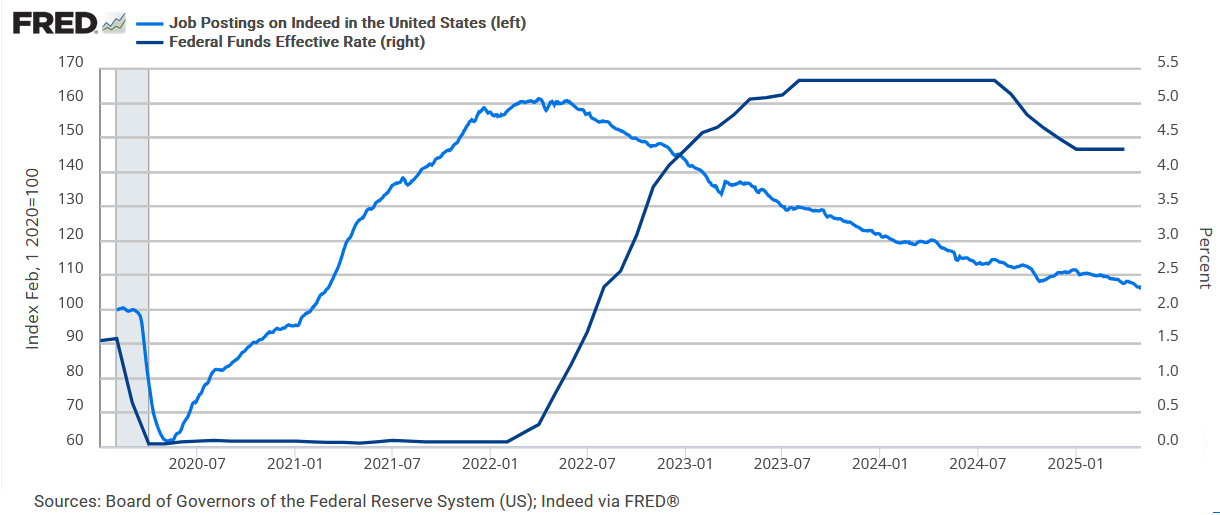
To explain, the dark blue line above tracks the U.S. federal funds rate (FFR), while the light blue line above tracks Indeed’s job postings. And while the latter is nearly back to where it was pre-pandemic, the FFR is roughly 3% higher than it was pre-pandemic. As a result, Powell’s focus on inflation could cause short-term interest rates to remain higher for longer than they should.
Yet, as tariff and inflation uncertainty handcuff the Fed, gold should remain a primary beneficiary. China’s central bank continues to stockpile gold, and robust demand could foster higher prices for several years. The World Gold Council noted recently:
“The People’s Bank of China (PBoC) has been adding gold to its reserves for five consecutive months: March saw a 2.8t reported addition to China’s official gold holdings and Q1 ended with a net gain of 12.8t.”
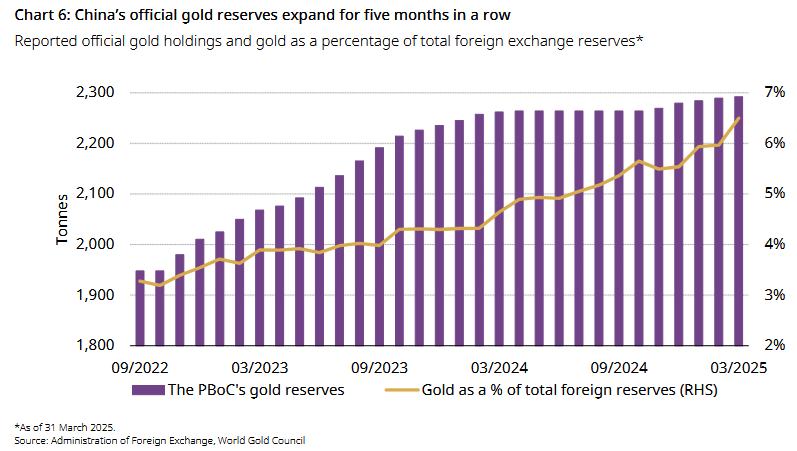
Likewise, Goldman Sachs noted that while the PBoC has been on a buying spree, it holds fewer than 8% of its total reserves in gold compared to a developed-market average of ~70%. Moreover, an achievable purchase allocation of 40 tonnes per month over the next three years could push the figure to 20% and create price support for the foreseeable future.

Are you thinking about diversifying into precious metals? Talk to your financial advisor about initiating a gold IRA account today, allowing you to invest in this red-hot asset on a tax-advantaged basis. Additionally, our complimentary CPI inflation calculator remains at your disposal, enabling you to assess inflation’s impact on your finances. Please seek the guidance of a financial advisor before making any investment decision.
In addition, if credit concerns have increased alongside the economic uncertainty, you’re not alone. New Era Debt Solutions is a top-rated debt settlement company that can help alleviate unsecured claims in as little as 24 to 48 months. Similarly, Family Credit Management is an excellent nonprofit credit counseling agency that provides the education and resources necessary to determine the optimal path to financial well-being.
Remember, speaking with a professional can help you avoid bankruptcy and protect your credit score. To learn more, please consult our list of debt management firms that can help get you back on track.

by Alex Demolitor | Apr 10, 2025 | Definitions
The March 2025 Consumer Price Index of All Urban Consumers (CPI-U) report indicates that inflation declined by 0.1% for the month, reversing February’s 0.2% rise. These data were released at 8:30 am EST on Thursday, April 10, 2025, by the Bureau of Labor Statistics. Before seasonal adjustment, the year-over-year (Y-o-Y) inflation rate in the all-items index grew by 2.4%, a continued deceleration from 2.8% in February, 3.0% in January, and 2.9% in December.
The downside surprise was more welcome news, as the results missed economists’ consensus estimates. The table below is courtesy of Investing.com. The left column represents March’s figures, while the right column represents forecasters’ expectations. As you can see, the red metrics were weaker than anticipated.

Despite that, Fed Chairman Jerome Powell has maintained a cautious outlook and said on Apr. 4:
“While uncertainty remains elevated, it is now becoming clear that the tariff increases will be significantly larger than expected. While tariffs are highly likely to generate at least a temporary rise in inflation, it is also possible that the effects could be more persistent. We are well positioned to wait for greater clarity before considering any adjustments to our policy stance. It is too soon to say what will be the appropriate path for monetary policy.”
As a result, while the data has cooperated recently, Powell still prefers further evidence of disinflation to warrant more rate cuts.
Gasoline, transportation services, and used cars and trucks drove March’s downside momentum, while shelter also slowed to 0.2% MoM.
Core inflation (which excludes the impacts of food and energy), rose by 0.1% in March, down from 0.2% in February and 0.4% in January. The indexes for airline fares, motor vehicle insurance, and recreation were among the primary laggards.

Food Prices
The food index jumped by 0.4% in March, after slowing to 0.2% in February. Although, two of the six major grocery store food indexes realized deflation:
- Cereals and bakery products (-0.1%)
- Meats, poultry, fish, and eggs (+1.3%)
- Dairy and related products (+1.0%)
- Fruits and vegetables (-0.5%)
- Nonalcoholic beverages (+0.6%)
- Other food at home (+0.5%)
Likewise, the food away from home index rose by 0.4%, as restaurant inflation remains resilient.
Energy Prices
The energy index fell by 2.4% in March, after rising by 0.2% in February and 1.1% in January. Gasoline prices sunk by 6.3%, while natural gas and electricity inflation jumped by 3.6% and 0.9%.
Core CPI
The March core CPI rose by 0.1% month-over-month and 2.8% Y-o-Y. Below is an itemized breakdown of the main price fluctuations seen in the core CPI reading:
- Shelter index: (+0.2%) [February: +0.3%]
- Rent index: (+0.3%) [February: +0.3%]
- Owners’ equivalent rent: (+0.4%) [February: +0.3%]
- Motor vehicle insurance: (-0.8%) [February: +0.3%]
- Medical care services: (+0.5%) [February: +0.3%]
- Physician services: (+0.3%) [February: +0.4%]
- Hospital services: (+1.1%) [February: +0.1%]
- Airline fares: (-5.3%) [February: -4.0%]

Seasonally Unadjusted CPI Data for March
Before seasonal adjustments, the CPI-U for March 2025 increased by 2.4% Y-o-Y to an index level of 319.799. Since these figures are unadjusted, they include regular seasonal price fluctuations that can create volatility in the results.
Who Blinks First?
Although Powell has preached patience when it comes to future rate cuts, the economic backdrop has become more precarious. With trade wars and stock market volatility intensifying, the sour sentiment could weigh on corporations’ investment decisions and eventually result in higher unemployment. As a result, the second half of the Fed’s dual mandate could dominate the longer the uncertainty persists.
Furthermore, the dichotomy in inflation expectations could have Powell looking in the wrong direction. For example, the University of Michigan’s latest Consumer Sentiment Report showed a material rise in Americans’ inflation fears. An excerpt read:
“As of March 2025, long-run expectations have climbed sharply for three consecutive months and are now comparable to the peak readings from the post-pandemic inflationary episode. They exhibit substantial uncertainty, particularly in light of frequent developments and changes with economic policy.”

Conversely, the 5y5y tells a different story. For context, the metric measures institutional investors’ five-year inflation expectation five years from today. If you analyze the right side of the chart below, you can see that the 5y5y has declined considerably in 2025 and remains near the Fed’s 2% long-run target.
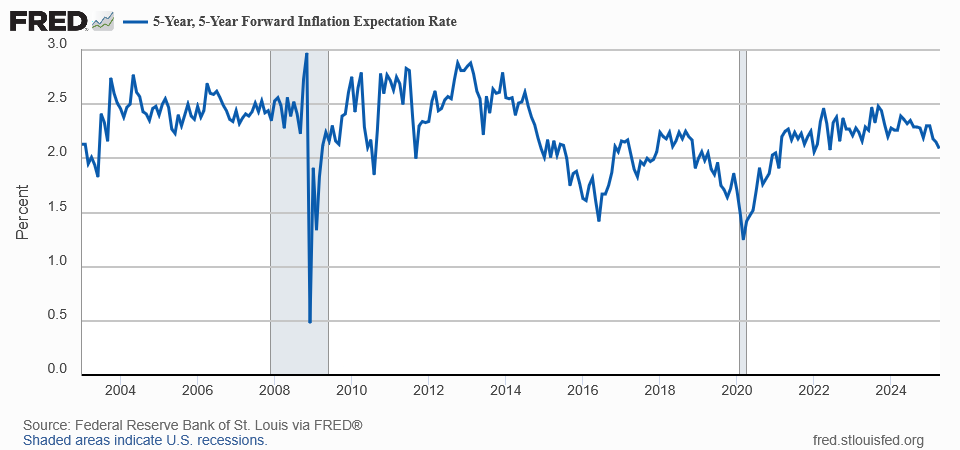
Add it all up, and Powell has to decide whether he believes consumers or investors assessment of future inflation.
In the meantime, while stocks have gyrated, gold continues to outperform. And while developed-market central banks have large gold reserves, emerging market purchases could be the next catalyst to push prices higher.
The Goldman Sachs chart below shows how EM central banks have relatively small gold holdings. But, if they follow their DM counterparts and increase their allocations, the gold price could shine even brighter in the months ahead.

Are you thinking about diversifying into precious metals? Talk to your financial advisor about initiating a gold IRA account today, allowing you to invest in this red-hot asset on a tax-advantaged basis. Additionally, our complimentary CPI inflation calculator remains at your disposal, enabling you to assess inflation’s impact on your finances. Remember, seek the guidance of a financial advisor before making any investment decision.
In addition, if debt troubles have increased alongside the economic uncertainty, you’re not alone. Speaking with a professional can help you avoid bankruptcy and protect your credit score. To learn more, consult our list of debt management firms that can help get you back on track.

by Alex Demolitor | Mar 12, 2025 | Definitions
The February 2025 Consumer Price Index of All Urban Consumers (CPI-U) report indicates that inflation increased by 0.2% for the month, a drop from January’s 0.5% rise. These data were released at 8:30 am EST on Wednesday, March 12, 2025, by the Bureau of Labor Statistics. Before seasonal adjustment, the year-over-year (Y-o-Y) inflation rate in the all-items index grew by 2.8%, falling from 3.0% in January and 2.9% in December.
The downside surprise was welcome news, as the results missed economists’ consensus estimates. The table below is courtesy of Investing.com. The left column represents February’s figures, while the right column represents forecasters’ expectations. As you can see, the red metrics were weaker than anticipated.

Despite that, Fed Chairman Jerome Powell has maintained a wait-and-see approach to rate cuts. On Mar. 7, he said, “The U.S. economy continues to be in a good place. We do not need to be in a hurry and are well-positioned to wait for greater clarity.”
“The path to sustainably returning inflation to our target has been bumpy, and we expect that to continue,” Powell said. “We see ongoing progress in categories that remain elevated, such as housing services and the market-based components of non-housing services.”
As a result, while he noted the “uncertainty” around tariffs and U.S. immigration policy, patience is his preferred approach for the time being.
Used cars and trucks and utility pipelines were primary outliers on the upside this month, while gasoline and transportation services were noticeably weak.
Core inflation (which excludes the impacts of food and energy), rose by 0.2% in February, down from 0.4% in January. And even with the welcome deceleration in shelter — dropping to 0.3% in February from 0.4% in January — the index accounted for “nearly half of the monthly all items increase.”

Food Prices
The food index slowed to 0.2% in February, and four of the six major grocery store food indexes realized deflation:
- Cereals and bakery products (+0.4%)
- Meats, poultry, fish, and eggs (+1.6%)
- Dairy and related products (-1.0%)
- Fruits and vegetables (-0.5%)
- Nonalcoholic beverages (-0.5%)
- Other food at home (-0.5%)
Conversely, the food away from home index rose by 0.4% (surpassing January’s 0.2% rise), as restaurant inflation accelerated in February.
Energy Prices
The energy index rose by 0.2% in February, down from 1.1% in January. Gasoline prices fell by 1%, while natural gas and electricity inflation jumped by 2.5% and 1%.
Core CPI February 2025
The February core CPI rose by 0.2% month-over-month and 3.1% Y-o-Y. Below is an itemized breakdown of the main price fluctuations seen in the core CPI reading:
- Shelter index: (+0.3%) [January: +0.4%]
- Rent index: (+0.3%) [January: +0.3%]
- Owners’ equivalent rent: (+0.3%) [January: +0.3%]
- Motor vehicle insurance: (+0.3%) [January: +2.0%]
- Medical care services: (+0.3%) [January: +0.0%]
- Physician services: (+0.4%) [January: +0.1%]
- Hospital services: (+0.1%) [January: +0.9%]
- Airline fares: (-4.0%) [January: +1.2%]

Seasonally Unadjusted CPI Data for February 2025
Before seasonal adjustments, the CPI-U for February 2025 increased by 2.8% Y-o-Y to an index level of 319.082. Since these figures are unadjusted, they include regular seasonal price fluctuations that can create volatility in the results.
Behind the Curve?
With the Fed focused on tariffs and U.S. fiscal policy, some analysts believe the Committee’s unwillingness to cut interest rates could backfire in the future. If the economy is weaker than it anticipates, a ‘behind the curve’ Fed implies that interest rates are too high relative to the fundamental backdrop.
As an unsettling example, Challenger, Gray, and Christmas noted on Mar. 6 that “Job Cuts Surge on DOGE Actions, Retail Woes; Highest Monthly Total Since July 2020.”
The report stated:
“U.S.-based employers announced 172,017 job cuts in February, the highest total for the month since 2009 when 186,350 job cuts were recorded. It is the highest monthly total since July 2020 when 262,649 cuts were announced….
“February’s total is a 245% increase from the 49,795 cuts announced one month prior. It is a 103% increase from the 84,638 cuts announced in the same month last year. So far this year, employers have announced 221,812 job cuts, the highest year-to-date (YTD) total since 2009 when 428,099 job cuts were planned.”

Likewise, Truflation estimates the U.S. CPI is closer to 1.32% Y-o-Y based on its data, and the reading has declined materially in 2025. Thus, if the forecast proves prescient and the labor market weakens, a major shift in rate-cut expectations could unfold in the months ahead.
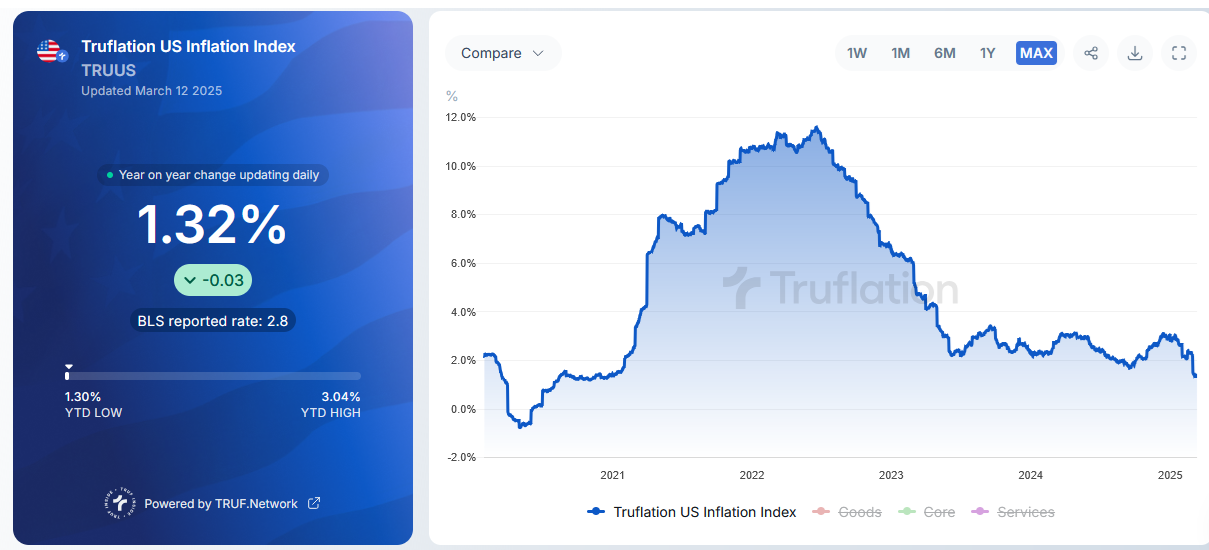
In the meantime, while stocks have been crushed recently, gold continues to shine bright. In fact, after years of underperformance, the yellow metal is now outperforming cash, bonds, and to a lesser degree, stocks. As such, it’s an excellent diversifier during uncertain periods.

Are you thinking about diversifying into precious metals? Talk to your financial advisor about initiating a gold IRA account today, allowing you to invest in this red-hot asset on a tax-advantaged basis. Additionally, our complimentary CPI inflation calculator remains at your disposal, enabling you to assess inflation’s impact on your finances. Remember, seek the guidance of a financial advisor before making any investment decision.

by Alex Demolitor | Feb 12, 2025 | Definitions
The January 2025 Consumer Price Index of All Urban Consumers (CPI-U) report indicates that inflation increased by 0.5% for the month, surpassing December’s 0.4% rise. These data were released at 8:30 am EST on Wednesday, February 12, 2025, by the Bureau of Labor Statistics. Before seasonal adjustment, the year-over-year (Y-o-Y) inflation rate in the all-items index grew by 3.0%, up from 2.9% in December and 2.7% and 2.6% in November and October.
The magnitude of the strength was largely unexpected, as the results easily surpassed economists’ consensus estimates. The table below is courtesy of Investing.com. The left column represents January’s figures, while the right column represents forecasters’ expectations. As you can see, the green metrics highlight January’s outperformance.

The data is likely an unwelcome sign for Fed Chairman Jerome Powell, as he’s shifted his stance in a hawkish direction recently. He said on Feb. 11:
“With our policy stance now significantly less restrictive than it had been and the economy remaining strong, we do not need to be in a hurry to adjust our policy stance. We know that reducing policy restraint too fast or too much could hinder progress on inflation.”
Thus, with January’s results amplifying that message, it could be a while before investors receive the rate cuts they desire.
Used cars and trucks were primary outliers again this month, with energy-related items like gasoline, fuel oil, and utilities also recording significant MoM increases. Likewise, food inflation was the highest in five months.
Core inflation (which excludes the impacts of food and energy), rose by 0.4% in January, a jump from December’s 0.2% print. And despite the decline in real-time rents, shelter rose by 0.4% MoM and accounted for “nearly 30 percent of the monthly all items increase.”

Food Prices
The food index hit a five-month high in January, and four of the six major grocery store food indexes increased:
- Cereals and bakery products (-0.4%)
- Meats, poultry, fish, and eggs (+1.9%)
- Dairy and related products (+0.3%)
- Fruits and vegetables (-0.5%)
- Nonalcoholic beverages (+0.9%)
- Other food at home (+0.3%)
In addition, the food away from home index rose by 0.2%, as restaurant inflation slowed in January.
Energy Prices
The energy index rose by 1.1% in January, with gasoline and natural gas up by 1.8%, respectively, while electricity was flat.
Core CPI January 2025
The January core CPI rose by 0.4% month-over-month and 3.3% Y-o-Y. Below is an itemized breakdown of the main price fluctuations seen in the core CPI reading:
- Shelter index: (+0.4%) [December: +0.3%]
- Rent index: (+0.3%) [December: +0.3%]
- Owners’ equivalent rent: (+0.3%) [December: +0.3%]
- Motor vehicle insurance: (+2.0%) [December: +0.4%]
- Medical care services: (+0.0%) [December: +0.2%]
- Physician services: (+0.1%) [December: +0.1%]
- Hospital services: (+0.9%) [December: +0.2%]
- Airline fares: (+1.2%) [December: +3.9%]

Seasonally Unadjusted CPI Data for January 2025
Before seasonal adjustments, the CPI-U for January 2025 increased by 3.0% Y-o-Y to an index level of 317.671. Since these figures are unadjusted, they include regular seasonal price fluctuations that can create volatility in the results.
Seeking Shelter
With inflation refusing to recede, the financial markets remain unnerved at the prospect of higher-for-longer interest rates. However, one sign of hope is the eventual decline of rental inflation.
The shelter CPI accounts for more than 30% of the headline CPI’s movement, and Apartment List noted on Jan. 27:
‘Our national rent index started the year with its sixth straight month-over-month decline, falling by 0.2 percent in January. Year-over-year growth also remains negative at -0.5 percent, but is slowly inching back toward positive territory.”

The report added:
“The Apartment List National Rent Index has proven to be a strong leading indicator of the CPI housing and rent components (collectively referred to as “shelter”), since our index captures price changes in new leases, which are only later reflected in price changes across all leases (what the CPI measures)….
“Despite the progress, shelter CPI remains elevated and is one of the key factors continuing to exert upward pressure on topline CPI. In fact, if you strip out shelter, the remainder of the CPI price basket has increased by just 1.9 percent year-over-year as of December, right in line with the Fed’s long-term 2 percent inflation target. As shelter inflation continues to trend down, it will help improve the overall inflation picture.”
Consequently, while January’s CPI print worsened the inflation outlook, there are some positive signs that could flip the script in the months ahead.
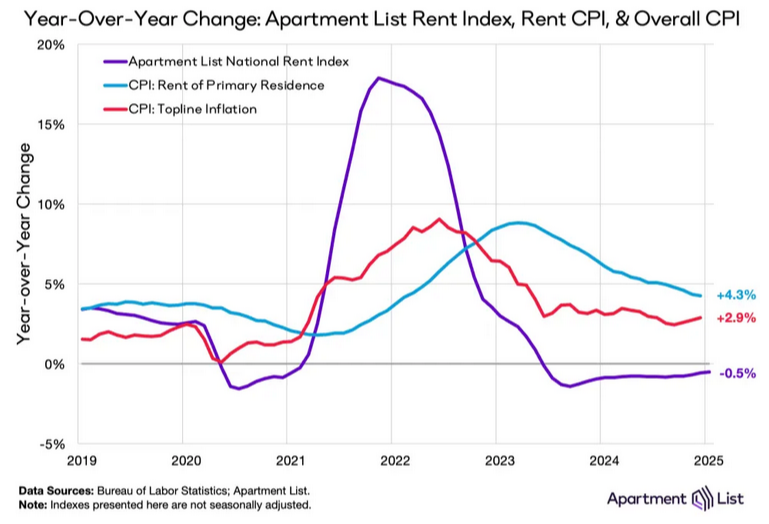
In the meantime, while some assets have suffered recently, as higher interest rates on risk-free assets like Treasury bonds make risky assets like stocks seem less attractive, gold has shined bright. Moreover, the World Gold Council noted on Feb. 10 that gold’s “record-breaking performance attracted investor attention.”
An excerpt read:
“European funds saw their largest monthly inflow since March 2022, adding US$3.4bn during January. UK and Germany dominated inflows. In the UK, government bond yields fell notably during the second half of January as easing inflation pressure and soft economic data prints raised investor expectations for rate cuts from the Bank of England during 2025. Reduced opportunity cost of holding gold, alongside a robust gold price performance, drove local investors into gold ETFs.”
As such, more upside could materialize as inflation, geopolitical uncertainty, and tariff concerns fester throughout 2025.

Are you thinking about diversifying into precious metals? Talk to your financial advisor about initiating a gold IRA account today, allowing you to invest in this red-hot asset on a tax-advantaged basis. Additionally, our complimentary CPI inflation calculator remains at your disposal, enabling you to assess inflation’s impact on your finances. Remember, seek the guidance of a financial advisor before making any investment decision.

by Alex Demolitor | Jan 15, 2025 | Definitions
The December 2024 Consumer Price Index of All Urban Consumers (CPI-U) report indicates that inflation increased by 0.3% for the month, surpassing November’s 0.2% rise. These data were released at 8:30 am EST on Wednesday, January 15, 2025, by the Bureau of Labor Statistics. Before seasonal adjustment, the year-over-year (Y-o-Y) inflation rate in the all-items index grew by 2.9%, a rise from the 2.7% and 2.6% witnessed in November and October.
Despite the monthly acceleration, the results matched or missed economists’ consensus estimates. The table below is courtesy of Investing.com. The left column represents December’s figures, while the right column represents forecasters’ expectations. As you can see, a weaker-than-expected core CPI was the headliner.

The data may be a relief for FOMC Chairman Jerome Powell, as the committee shifted from a dovish labor-market-driven tone to a hawkish inflation-driven tone. He said during his post-meeting press conference on Dec. 18:
“Inflation itself is way down, but people are still feeling high prices. The best we can do for them is to get inflation back down to its target and keep it there so that people are earning, you know, big, real wage increases so that their, their wages are going up, their compensation is going up faster than inflation year upon year upon year. And that’s what will restore people’s good feeling about the economy. That’s what it will take, and that’s what we’re aiming for.”
Used cars and trucks were the primary outlier again this month, with the segment rising by 1.2% MoM in December. Similarly, energy-related items like gasoline and utilities recorded significant increases.
Core inflation (which excludes the impacts of food and energy), rose by 0.2% in December, a decline from November’s 0.3% print. Moreover, with real-time rents down sharply on an annual basis, a weaker shelter component should aid the core CPI in the months ahead.

Food Prices
The food index slowed in December, rising by 0.3% versus 0.4% in November. Four of the six major grocery store food indexes increased:
- Cereals and bakery products (+1.2%)
- Meats, poultry, fish, and eggs (+0.6%)
- Dairy and related products (+0.2%)
- Fruits and vegetables (-0.1%)
- Nonalcoholic beverages (-0.4%)
- Other food at home (+0.3%)
In addition, the food away from home index rose by 0.3%, as restaurants priced their products in line with overall food inflation.
Energy Prices
The energy index rose by 2.6% in December, a noticeable jump from the 0.2% recorded in November. Gasoline and natural gas prices rose by 4.4% and 2.4%, respectively, while electricity rose by 0.3%.
Core CPI December 2024
The December core CPI rose by 0.2% month-over-month and 3.2% Y-o-Y. Below is an itemized breakdown of the main price fluctuations seen in the core CPI reading:
- Shelter index: (+0.3%) [November: +0.3%]
- Rent index: (+0.3%) [November: +0.2%]
- Owners’ equivalent rent: (+0.3%) [November: +0.2%]
- Motor vehicle insurance: (+0.4%) [November: +0.1%]
- Medical care services: (+0.2%) [November: +0.4%]
- Physician services: (+0.1%) [November: +0.3%]
- Hospital services: (+0.2%) [November: +0.0%]
- Airline fares: (+3.9%) [November: +0.4%]

Seasonally Unadjusted CPI Data for December 2024
Before seasonal adjustments, the CPI-U for December 2024 increased by 2.9% Y-o-Y to an index level of 315.605. Since these figures are unadjusted, they include regular seasonal price fluctuations that can create volatility in the results.
Too Hawkish?
With the FOMC shifting its stance in a hawkish direction on Dec. 18, inflation had taken precedence over the labor market. Powell added:
“You saw in the SEP that risks and uncertainty around inflation we see as higher. Nonetheless, we see ourselves as still on track to continue to cut. I think the actual cuts that we make next year will not be because of anything we wrote down today. We’re, we’re going to react to data. That’s just the general sense of what the Committee thinks is likely to be appropriate.”
To explain, the FOMC releases its Summary of Economic Projections (SEP) four times per year, and include members’ forecasts for GDP growth, inflation, unemployment, and the federal funds rate (FFR).
If you analyze the red box below, you can see that the consensus estimate was for 100 basis points of rate cuts and a 3.4% FFR in 2025. But, with economic data outperforming, the FFR projection was increased to 3.9%, which means only 50 basis points of rate cuts.

Add it all up, and the hawkish shift implies stricter monetary policy throughout 2025. Yet, with the core CPI data underperforming today, more of the same could lead to a shift back to dovish projections in the months ahead.
In the meantime, asset prices have suffered recently, as higher interest rates on risk-free assets like Treasury bonds make risky assets like stocks, gold, and silver seem less appealing.
However, Goldman Sachs and Bank of America still expect the yellow metal to exceed $2,800 and post a new record high in 2025. If you analyze the Bloomberg chart below, you can see that both investment banks see gold maintaining its strength throughout the year.

Are you thinking about diversifying into precious metals? Talk to your financial advisor about initiating a gold IRA account today, allowing you to invest in this red-hot asset on a tax-advantaged basis. Additionally, our complimentary CPI inflation calculator remains at your disposal, enabling you to assess inflation’s impact on your finances. Remember, seek the guidance of a financial advisor before making any investment decision.





































